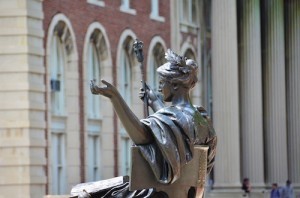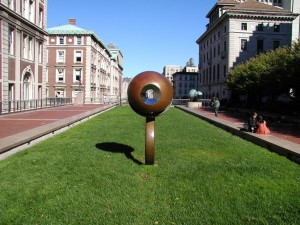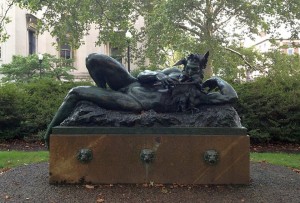
Alma Mater (1903), designed by Daniel Chester French, on the steps of Low Library
When the Museum Meetup: Art on Campus tour appeared on the Jerry’s Picks list for October 20, I immediately signed up. My curiosity about the outdoor sculptures on Columbia’s campus was first piqued when my grandson, Cole, and I chose Columbia’s campus as the subject for his second-grade class assignment, a report on a New York City historical site. Cole wanted to visit the Empire State Building; I did not. So, I enticed him with a challenge – that he would not be able to find the owl hidden among the folds of Alma Mater’s robes. We spent the afternoon of August 19 on the Morningside Campus.
Of course, our first stop was Alma Mater, and three hours later we had photos of every sculpture of interest to Cole. Although I was able to guide him in his search for the owl, I could not answer most of his questions about the sculptures. And, now, the opportunity for me to learn had presented itself.

“Life Force” (1988-92) by David Bakalar, on Revson Plaza
Roberto C.Ferrari, curator of Art Properties at Columbia University, led our group of 30 to several sculptures, each with a unique story. More generally, Roberto explained that outdoor sculpture is intended to be in our way. It is there for our interaction. He also pointed out the challenges posed by the conservation of outdoor sculpture, which are both physical and financial: only three of Columbia’s outside sculptures—Alma Mater, Thomas Jefferson, and Life Force—have endowments for their permanent care.

“The Great God Pan” (1863-1938) by George Grey Barnard, on the Lewisohn Hall lawn. Photograph by Roberto C. Ferrari
We met at Alma Mater, the most popular public sculpture on Columbia’s campus. Roberto encouraged us to interact with the sculpture, to walk around her, and to find something we had not noticed previously. This exercise produced many different comments and questions, all of which Roberto addressed, often adding something we didn’t notice. In addition to Alma Mater, our tour included The Great God Pan, John Howard Van Amringe, The Thinker, and the many artworks in front of the Law School.
And, as we walked through the Morningside Campus on a beautiful fall day, Roberto enlightened us with, not only the history of these works and their artists, but stories of superstitions, intercollegiate pranks, student songs, and so much more.

“The Thinker” (1880-82) by Auguste Rodin, outside Philosophy Hall
To learn more about Columbia’s public art and the artists, visit Roberto’s blog at https://blogs.cul.columbia.edu/outdoorsculpture. Also, check out Columbia Magazine’s feature story Treasure Quest.
